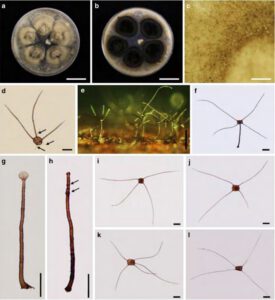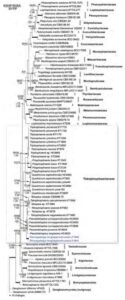Shrungabeeja longiappendiculata Sommai, Pinruan, Nuankaew & Suetrong, in Ariyawansa et al., Fungal Diversity: 10.1007/s13225-015-0346-5, [98] (2015)
Index Fungorum Number: IF 551322; Facesoffungi number: FoF00967;
Etymology – longiappendiculata referring to the long appendages.
Holotype – BBH 39513
Saprobic on dead culm of Bambusa sp. in evergreen forest. Colonies effuse, brown to dark brown. Mycelium partly superficial, partly immersed in the substratum, composed of branched, septate, pale brown, smooth-walled hyphae, 2–4 μm wide. Sexual morph: Undetermined. Asexual morph: Conidiophores macronematous, mononematous, erect, straight or flexuous, unbranched, smooth, thick-walled, 132.5–225 μm long, 11.25–15 μm wide at the base, 6.25–10 μm wide in the middle, up to 5 μm wide at the apex, 3–4-septate. Conidiogenous cells monoblastic, terminal, lageniform, determinate or percurrent, pale brown to brown, smooth, 12.5–25 μm long, 6–7.5 μm broad at base, up to 5–7.5 μm. broad at apex. Conidia solitary, dry, acrogenous, subglobose or turbinate, aseptate, hollow, pedicellate, with 4–7 filiform appendages in the anterior region which are continuous or sometimes 4–21-septate, smooth, pale brown to brown, conidia 32.5–50 μm long, 40–60 μm wide, 5–7.5 μm broad at the base, broader than long, appendages (47.5–82.5) 100–360 (400–480) μm long, 5–7.5 μm broad at base, and 1.25 μm at apex.
Culture characteristics – Colonies on PDA attaining 4–4.5 cm diam. after 20 days at room temperature (25 °C), cottony, grey, with entire margin, reverse almost black, no pigment produced, sporulating.
Material examined – THAILAND, Nakhon Nayok Province, on dead culm of Bambusa sp. (Poaceae), 3 September 2014, S. Sommai (BBH 39513, holotype); ex-type living culture, BCC 76463.
Notes – Shrungabeeja species have dark conidiophores with integrated, terminal, monoblastic, determinate or percurrent conidiogenous cells and lageniform, acrogenous, solitary, aseptate, globose or turbinate conidia, with filiform or horn-like appendages (Rao and Reddy 1981). There are no known sexual morphs. Shrungabeeja longiappendiculata differs from all species of Shrungabeeja as it has 40–60×32.5–50 μm conidia, with 4–7 very long appendages. Maximum parsimony, likelihood and Bayesian analyses of combined SSU and LSU gene region of 80 taxa from the Dothideomycetes place Shrungabeeja longiappendiculata in Tetraplosphaeriaceae with Tetraplosphaeria and Pseudotetraploa species with 63 % BSMP, 78 % BSBL and 1.00 B.P. ITS rDNA gene analysis shows two isolates of Shrungabeeja longiappendiculata clustered with species of Triplosphaeria and Quadricrura and Polyplosphaeria fusca in Tetraplosphaeriaceae (Fig. 58). Based on the above morphological and molecular characteristics, Shrungabeeja longiappendiculata is introduced as a new species and placed in Tetraplosphaeriaceae.

Fig. 1 Shrungabeeja longiappendiculata (holotype) a, b Colony on PDA, a from above, b from below. c Sporulation on PDA d Germinating conidium (arrowed). e Colonies on natural substratum. f Conidiophore with mature conidium. g Conidiophore with developing conidium. h Conidiophore showing percurrent proliferation (arrowed). i–l Conidia with appendages. Scale bars: a–c=10 mm, d, g, h, i–l=50 μm, e–f=10 μm

Fig. 57 One of three MPTS inferred from combined SSU and LSU rDNA sequence data of Dothideomycetes, generated with maximum parsimony. Maximum parsimony (BSMP, left) and likelihood (BSML, right) bootstrap values >50 % are given above the nodes. Bayesian posterior probabilities >0.95 are given below each node (BYPP). The internodes that are highly supported by all bootstrap (100 %) and posterior probabilities (1.00) are shown as a thicker line.
